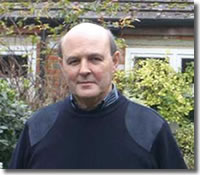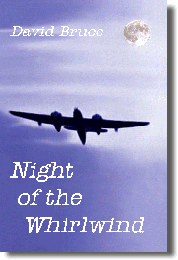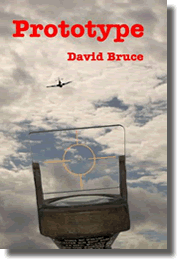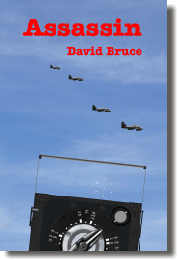Author
 |
I have been interested in aviation since I was nine, when I had my first trip in an aircraft. It was a fascinating experience and in due course I joined the Air Training Corps. At seventeen, I was lucky enough to be awarded an RAF Flying Scholarship; and so ended up in the curious position of being qualified to fly an aircraft before I could even drive a car. (Liz, my wife, thinks that the roads of Britain would have been safer if it had stayed that way...) |
| David Bruce |
| I kept up the flying, and over the years I have managed to get my hands on a number of interesting types; Tiger Moth, Chipmunk, Harvard, SA Bulldog, Citabria, Breezy - plus a dozen or so other types of club machine. I would never describe myself as an aviator (that takes knowledge and skill...) I would describe myself as a flyer - happy to just get airborne when I can and throw a few aeros in those machines that can survive the odd mistake in handling. |
 |
| Life on Mars - me at twenty years of age - a qualified pilot for three years but still wondering how the world worked... |
| I am also drawn to the middle period of the war, when almost all of the less competent individuals had either been killed or replaced, the outcome of the air war was still up for grabs; and both sides now exercised a deadly professionalism. Of course, a huge number of aviation novels have been written since the war, and most fictional themes have been covered time and time again, and as a consequence I have been prompted to look for subjects that are a little different. |
 |
|
Wren Type VII |
I cannot claim to follow any particular literary style, although on the historical side I do like the direct and engaging narratives of Somerset Maugham; the realism of George Shipway; and the truly compelling attention to detail of Allan Mallinson (author of the "Hervey" Napoleonic cavalry novels) and Patrick O'Brian (author of the "Master and Commander" Napoleonic sea war series). For me, historical and technical accuracy are vital if the reader is to experience that sense of presence which is the hallmark of the successful historical novel. Allan Mallinson and Patrick O'Brian appear to achieve this almost effortlessly; the rest of us can only grit our teeth and keep slogging away. In my storytelling I am given rather more to action than to angst; which I think probably puts me closer to the "633 Squadron" genre rather than to "Catch 22".
I also have to confess to being an admirer of Admiral Halsey, who was famed for stating:
"There are no great men, there are only great challenges the ordinary men are forced by circumstances to meet."
While there clearly have been great men and women, Halsey's comment applies to countless men and women who served in the forces in WWII, and it has prompted me to write stories that feature credible characters, realistic events, and keep accurate history and technology to the fore.
The approach seems to work as two serving RAF officers who read "Prototype" believed it to be a story based on real events.
Some people write Whodunits, and some people write Whydunits; I write Howdunits.
The circumstances surrounding the writing of each novel are described below:
Finishing School
 |
Finishing School was my fourth novel and, after having written three novels that were based on slightly less usual subjects, I decided to write a story that was firmly in the mainstream of WWII aviation. A brief look at the novels about Bomber Command over the last sixty years made me realise that one critical period in the training of a Lancaster bomber crew had been missed: that of the time spent at Lancaster Finishing School before joining an operational squadron.
|
The setting for the novel is the real-life 5 LFS, which was based at RAF Syerston in Nottingham, and the fictional 599 Squadron, based at the fictional RAF Toynby in Lincolnshire. However, the fictional side was firmly set in the real histories of the squadrons of Bomber Command.
Falcon
While writing Finishing School, it became apparent that the characters could, and should, be the basis for a series of novels, so when Finishing School was completed I set about writing the next. While Finishing School had, of necessity, been an ultra-accurate rendition of life in Bomber Command, the next novel could be loosened up in a number of ways. There would still be the leadership of Hugh MacKay, the solid presence of his flight engineer, and the constant sparring of that womanizing duo the wireless operator and the rear gunner, but the plot itself could take on more of the aspect of a thriller. And the lives of the crew, plus the possibilities of romance, could begin to expand.
|
 |
Again, my "literary panel", which now included the ex-members of Bomber Command who had helped me with Finishing School, liked it a lot.
Night Of The Whirlwind
 |
I have had a liking for the Westland Whirlwind since childhood. There is a truly graceful look to that pencil-slim fuselage, and a powerful aspect to those bulging engine nacelles that pulled the Whirlwind along like the pods of a Star Wars racer. It seemed to me to be a very deserving subject for a novel - yet no-one had ever written one. So, I bought a copy of Victor Bingham's marvellous textbook "Whirlwind" and started work. |
The setting for the novel is 137 Squadron RAF, which was formed in September 1941 as the second squadron to be equipped with the Whirlwind fighter. 137 operated the Whirlwind fighter until June 1943.
A project has now been put in place to create a replica of a Westland Whirlwind fighter. To go to the site of the Whirlwind Fighter Project, click here.
Scorpion Force
It seemed a shame not to follow the career of Flight Lieutenant John "Jackers" Ackroyd and his fellow flyers in the period following 137 Squadron's changing over from the Whirlwind to the heavily-armed version of the Hurricane, so further exciting employment in 1943 had to be found. The answer came in the form of the plans being laid for Operation Starkey in the autumn of 1943, and the tasks set for this for the RN's Light Coastal Forces; in other words the MTBs that went hunting in the coast around Britain, night after night, for enemy warships and shipping. An enjoyable time was spent researching the role and operations of the MTBs; and how they could have worked together with a crack RAF squadron to neutralise an enemy threat before it wrecked a vital operation. |
 |
Trespass in Heaven
 |
The fascination for the wartime activities of the Westland company continued to inhabit me! I turned my attention to the Whirlwind's younger, but bigger, brother; the Westland Welkin. The Welkin was conceived as a high-altitude fighter, designed to intercept high-flying German bombers and reconnaisance aircraft. However, although more than one hundred Welkins were built they never saw action. However, had the Germans tweaked the performance of the high-altitude aircraft they did possess, then by 1944 these could have been used to discover the Allies' preparations for D-Day, and only the Welkin would have stood a chance of intercepting them. So, I began to deeply research both the Welkin and the company that had designed it. I was most fortunate to be able to have conversations with Ian Penrose, the son of Harald 'Hal' Penrose, Westland's test pilot during WW2, and David Gibbings; engineer, historian, author, and artist, who had worked with Hal. Between them, they gave me a unique picture of Hal and the Westland company. The finished tale was a fair attempt to describe, although only fictionally, the contribution made by Westland and its employees to the great advances in high-altitude flight that occurred after WW2. |
Prototype
Nowadays, the Martin Baker company is best known for its ejector seats, which have saved thousands of lives. However, aviation enthusiasts will know that during WWII they built two fighter prototypes; the MB3 and the MB5. The MB3 was powered by the Napier Sabre engine, which in 1942 was causing much grief to the squadrons operating the new Typhoon fighter. Indeed, the MB3 was lost when its engine failed on approach, and its pilot, Captain Baker, was killed. |
 |
Assassin
 |
"Prototype" simply cried out for a sequel, and so the next story describes how the Wren Aeroplane Company are asked to build a jet fighter. This was a far from unlikely scenario as in 1943 another small aircraft company was asked to build a jet aircraft - and a supersonic one to boot! This was the famous Miles M.52, and although it was cancelled before it flew, a scale model of it cruised effortlessly through the sound barrier after the war. |
The Prototypes
The two "prototype" stories were so distinct a pair of novels that I thought an omnibus edition might be a good idea, so I brought out a volume which contained both stories together. I also had a lot of fun creating the "blueprint" cover. Enjoy! |
 |
The Turning Of The Tide
 |
Another deep interest in my life has been the Anglo-Saxon period in England. The raids of the Vikings, and their later decision to move to England permanently, caused an immense amount of grief to the Anglo-Saxon peoples and Alfred became dubbed "The Great" because of the noteworthy actions he took to contain them and then to drive them back. But the story did not end there. After Alfred's death the torch was passed to his children, Edward the new king of Wessex and Aethelflaed, the daughter who married Aethelred of Mercia and who, after his death, became the Lady of the Mercians and proved as determined a foe of the Danes as her father and brother. A close examination of the Anglo Saxon Chronicle of the period will reveal a few 'facts' that do not bear acceptance, and also immense scope for additional links in the chain of events. So, I hope that this rendition of the fightback against the Danes will prove enjoyable to the historical reader. |
Mission: Malaya
We are broadening our offering of novels! "Mission: Malaya" is a submarining tale set in the Far East in 1944. Highly researched, and featuring an abundance of action, it takes the reader in a prolonged combat patrol in the Anderman Sea |
 |
If you would like to get in touch with me, then please feel free to send an email to cairdcom@btopenworld.com
© Copyright 2007 CairdPublications.com | Site Map | Contact Us |


